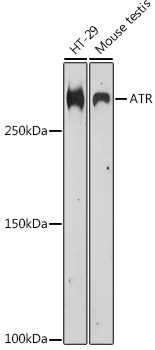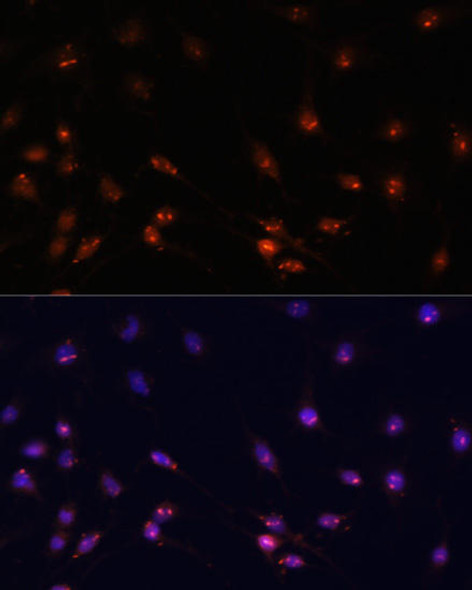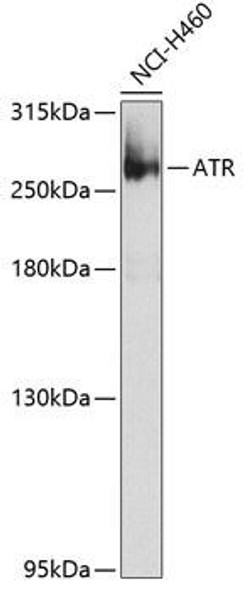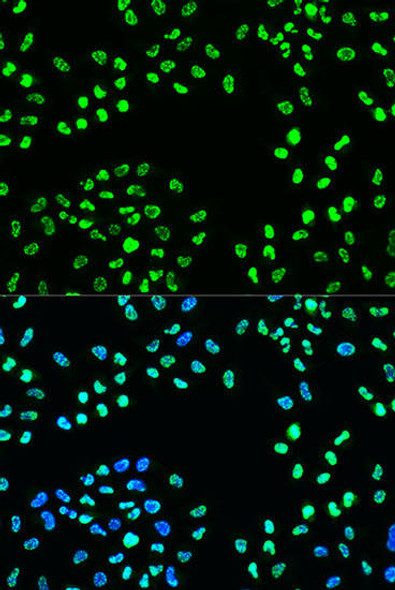Epigenetics & Nuclear Signaling Antibodies 1
Anti-ATR Antibody (CAB13951)
- SKU:
- CAB13951
- Product Type:
- Antibody
- Reactivity:
- Human
- Reactivity:
- Mouse
- Host Species:
- Rabbit
- Isotype:
- IgG
- Antibody Type:
- Polyclonal Antibody
- Research Area:
- Epigenetics and Nuclear Signaling
Description
| Antibody Name: | Anti-ATR Antibody |
| Antibody SKU: | CAB13951 |
| Antibody Size: | 20uL, 50uL, 100uL |
| Application: | WB |
| Reactivity: | Human, Mouse |
| Host Species: | Rabbit |
| Immunogen: | Recombinant fusion protein containing a sequence corresponding to amino acids 400-650 of human ATR (NP_001175.2). |
| Application: | WB |
| Recommended Dilution: | WB 1:500 - 1:2000 |
| Reactivity: | Human, Mouse |
| Positive Samples: | HT-29, Mouse testis |
| Immunogen: | Recombinant fusion protein containing a sequence corresponding to amino acids 400-650 of human ATR (NP_001175.2). |
| Purification Method: | Affinity purification |
| Storage Buffer: | Store at -20'C. Avoid freeze / thaw cycles. Buffer: PBS with 0.02% sodium azide, 50% glycerol, pH7.3. |
| Isotype: | IgG |
| Sequence: | LKME SMEI IEEI QCQT QQEN LSSN SDGI SPKR RRLS SSLN PSKR APKQ TEEI KHVD MNQK SILW SALK QKAE SLQI SLEY SGLK NPVI EMLE GIAV VLQL TALC TVHC SHQN MNCR TFKD CQHK SKKK PSVV ITWM SLDF YTKV LKSC RSLL ESVQ KLDL EATI DKVV KIYD ALIY MQVN SSFE DHIL EDLC GMLS LPWI YSHS DDGC LKLT TFAA NLLT LSCR ISDS YSPQ AQSR CVFL LTLF PRRI FLE |
| Gene ID: | 545 |
| Uniprot: | Q13535 |
| Cellular Location: | Chromosome, Nucleus, PML body |
| Calculated MW: | 294kDa/297kDa/301kDa |
| Observed MW: | 300KDa |
| Synonyms: | ATR, FCTCS, FRP1, MEC1, SCKL, SCKL1 |
| Background: | The protein encoded by this gene belongs the PI3/PI4-kinase family, and is most closely related to ATM, a protein kinase encoded by the gene mutated in ataxia telangiectasia. This protein and ATM share similarity with Schizosaccharomyces pombe rad3, a cell cycle checkpoint gene required for cell cycle arrest and DNA damage repair in response to DNA damage. This kinase has been shown to phosphorylate checkpoint kinase CHK1, checkpoint proteins RAD17, and RAD9, as well as tumor suppressor protein BRCA1. Mutations of this gene are associated with Seckel syndrome. An alternatively spliced transcript variant of this gene has been reported, however, its full length nature is not known. Transcript variants utilizing alternative polyA sites exist. |
| UniProt Protein Function: | ATR: a ser/thr kinase of the PIKK family most closely related to ATM. Activates checkpoint signaling upon genotoxic stresses such as ionizing radiation (IR), ultraviolet light (UV), or DNA replication stalling, thereby acting as a DNA damage sensor. Recognizes the substrate consensus sequence [ST]Q. Phosphorylates BRCA1, Chk1, MCM2, RAD17, RPA2, SMC1 and p53, which collectively inhibit DNA replication and mitosis and promote DNA repair, recombination and apoptosis. Phosphorylates 'Ser-139' of histone variant H2AX/H2AFX at sites of DNA damage, thereby regulating DNA damage response mechanism. Required for FANCD2 ubiquitination. Critical for maintenance of fragile site stability and efficient regulation of centrosome duplication. |
| UniProt Protein Details: | Protein type:Kinase, lipid; Protein kinase, Ser/Thr (non-receptor); Kinase, protein; Protein kinase, atypical; Membrane protein, integral; EC 2.7.11.1; ATYPICAL group; PIKK family; ATR subfamily Chromosomal Location of Human Ortholog: 3q23 Cellular Component: XY body; nucleoplasm; Golgi apparatus; PML body; chromosome Molecular Function:protein dimerization activity; protein serine/threonine kinase activity; protein binding; DNA binding; MutLalpha complex binding; MutSalpha complex binding; ATP binding; protein kinase activity Biological Process: response to drug; peptidyl-serine phosphorylation; negative regulation of DNA replication; regulation of protein binding; multicellular organismal development; protein amino acid autophosphorylation; DNA damage checkpoint; positive regulation of DNA damage response, signal transduction by p53 class mediator; DNA replication; DNA repair; cell cycle; response to DNA damage stimulus; double-strand break repair via homologous recombination Disease: Seckel Syndrome 1; Cutaneous Telangiectasia And Cancer Syndrome, Familial |
| NCBI Summary: | The protein encoded by this gene belongs the PI3/PI4-kinase family, and is most closely related to ATM, a protein kinase encoded by the gene mutated in ataxia telangiectasia. This protein and ATM share similarity with Schizosaccharomyces pombe rad3, a cell cycle checkpoint gene required for cell cycle arrest and DNA damage repair in response to DNA damage. This kinase has been shown to phosphorylate checkpoint kinase CHK1, checkpoint proteins RAD17, and RAD9, as well as tumor suppressor protein BRCA1. Mutations of this gene are associated with Seckel syndrome. An alternatively spliced transcript variant of this gene has been reported, however, its full length nature is not known. Transcript variants utilizing alternative polyA sites exist. [provided by RefSeq, Jul 2008] |
| UniProt Code: | Q13535 |
| NCBI GenInfo Identifier: | 62286460 |
| NCBI Gene ID: | 545 |
| NCBI Accession: | Q13535.3 |
| UniProt Secondary Accession: | Q13535,Q59HB2, Q7KYL3, Q93051, Q9BXK4, |
| UniProt Related Accession: | Q13535 |
| Molecular Weight: | 2644 |
| NCBI Full Name: | Serine/threonine-protein kinase ATR |
| NCBI Synonym Full Names: | ATR serine/threonine kinase |
| NCBI Official Symbol: | ATR |
| NCBI Official Synonym Symbols: | FRP1; MEC1; SCKL; FCTCS; SCKL1 |
| NCBI Protein Information: | serine/threonine-protein kinase ATR; FRAP-related protein-1; MEC1, mitosis entry checkpoint 1, homolog; ataxia telangiectasia and Rad3-related protein |
| UniProt Protein Name: | Serine/threonine-protein kinase ATR |
| UniProt Synonym Protein Names: | Ataxia telangiectasia and Rad3-related protein; FRAP-related protein 1 |
| Protein Family: | Atrophin |
| UniProt Gene Name: | ATR |
| UniProt Entry Name: | ATR_HUMAN |







